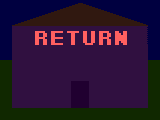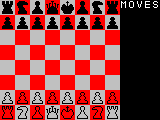
How do you play What Would you Do If...?
1. Introduction
What Would You Do If...? is a thinking game that can be played in parties or over online chat rooms as well. The history of it's development is very short and is on the bottom of this page. What it is is that someone asks a question that starts off very general. The one that answers must respond to your "what would you do if". The asker [the one who asks questions] makes it so that your response is limited. When they say that, the responder [the one that replies to a question] must reply with that and all other limitations included. Here's a sample to what you are looking forward to when you play:
asker: What would you do if you saw a volcano? (this is very general, and can lead to many answers).
responder: I'd take good pictures of it. (this is a general response)
asker: What if there was fog? (this is to cancel off the picture taking response because you wouldn't get a clear picture with fog)
responder: I'd do my usual stuff. (this is to reply as if the fog was there limiting pictures)
asker: What if the volcano was erupting? (this limits a lot of
possibilities)
responder: I'd find ways to get out of it's way. (this is a logical response for lava possibly heading your way from an eruption)
asker: What if a wall blocked your way around? (this is to make it harder for responses)
responder: I'd call 911 for emergency. (logical response)
asker: What if you forgot your phone? (to limit responses even
more)
responder: I'd find someone else. (this can really go on for a long time, so I'm not continuing much further) This is a general idea what the game is like. The rules follow.
2. How to play
When you play What Would You Do If...?, you need to know a few features, and is not as complex memorizing the rules, because there aren't many.
When you are the asker, you ask a very general question that can trigger several responses. The example above shows a very general thing and is a good example. What would you do if you saw a volcano? You could take pictures of it, you could just think of it as scenery, perhaps, just about anything. This only refers to the very first question.
Next, when the responder responds to the question, they must think of a quick but easy way to attract more responses. An example would be for the question of "What would you do if you saw a lake?" You could think of going away, but the asker could respond with "What if it was very hot?". If you think of swimming, the asker could respond with "What if the lake was very cold?" One response here can lead to several different outcomes.
Now the asker has to think of a way to majorly reduce the responses possible and it must start with "What if" every time. Now, the fog idea limits the camera, making picture-taking hard. With the volcano not really visible that well, the responder must think of something to reply to that and must consider that there is a volcano and that there is fog.
Now the responder thinks of doing his/her usual things, such as exploring, or watching TV. This can allow several good responses.
The asker says something about a way to severely limit their actions of their usual stuff, by saying that the volcano is erupting. Not only now does a volcano exist, there's fog, and now it's erupting, thinking becomes harder. The responder is in a hard situation now.
After 4 seconds of thinking with an optional 15-second thinking limit, (s)he only thought of escaping. Since this is basically the only response possible, there are quite a few possible ideas the asker can use.
This can continue on for a long time, until the responder cannot respond with any other answers that would be logical. Anything previously mentioned must be considered [the volcano is there, there's fog, the volcano is erupting, there's a barrier, etc.. Each time the responder makes a good response, (s)he scores one point. Then, the two players switch, and the responder is the asker, and the asker is now the responder. The asker, again, starts off very general. After the responder gets stumped (cannot respond with a logical answer or gives up), both scores are added together and thus the player with the highest of the two scores wins the round. Two games is one round. If there is a tie, there is a rematch of two games using different questions. The winner of these two games is the winner of the main game. If ties continue, these same two games repeat until someone wins, but with different questions each time.
3. The good and the bad
This section describes the good things and the bad things for both questions and responses. There are limits to what can be used.
Good: What would you do if you saw a lake?
Bad: What would you do if you saw a lake in the desert?
The reason why this is bad, is the fact of a lake and it being in the desert is two steps and is cheating. Those who do this get disqualified, or the asker loses a big five points, and the responder usually wins. The responder gets a score of ten, and the asker gets zero if the asker gets disqualified [if this occurs the second time in a competition, they are disqualified, but the first time is a loss of 5 points]. This can be quite tragic if you are in the tournament.
Good: I'd go swimming.
Bad: I'd die of heat!
This is an illegal response because it doesn't maintain to the topic and is a unfriendly response. The asker gets 10 points added on to their total, because it violates two things not maintaining the topic, and an unfriendly response (both deduct 5 points), but the responder drops to zero regardless of how many points he/she has, except if negative.
Good: making it within 15 seconds
Bad: taking longer than 15 seconds
[optional rule] This only relates to tournaments or if you choose to use it to speed up time. When the responder takes longer than 15 seconds, the game just simply ends (usually because he/she is stumped). If the asker takes 15 seconds, he/she loses 3 points and the round ends. The game also ends if the responder or the asker says something about them being stumped with no point deductions. They must indicate that they are stumped to not have the 3-point penalty.
Good:
asker: What would you do if you saw a mean-looking dog?
responder: I'd be careful.
asker: What if it attacks?
Bad:
asker: What would you do if you saw a mean-looking dog?
responder: I'd be careful.
asker: What if there was a computer?
This is going off of the topic. There is a 10-point penalty for this, and the game continues or ends [depending on the judge's decision]. This can be quite deadly. When you ask a question, no matter where you are in the game, this can be more disastrous. It can add 2 points for every other one after the question responding to the responder. This example takes 10 points, and if you countered the responder twice, the penalty grows to 14 if and only if you maintained being off topic, but penalties don't add on if you immediately revert back to the original question. Know what I mean?
Good:
Player 1 14+9+12 responses
Player 2 14+8+13 responses
14+9+12=35 14+8+13=35 TIE!
Bad:
Player 1 14+9+12 responses
Player 2 14+8+13 responses
14+9+12=36 14+8+13=34 Player 1 wins!
This is cheating, and the score for the cheater immediately goes to zero [if score was negative, it'd stay the same instead], thus giving the asker 0 and the responder 35 [a very bad record for the competition]. Make sure you do the math right, but if you're not sure, use a calculator, or count the values. Check your answer. For such simple math, you really shouldn't have this happen. Be accurate and honest.
This game is quite easy to understand, and involves good, fast thinking skills as well as logic. You don't really need anything at all. If you can display your score on your hands, you don't really need paper or pencil. This game requires two players only, and can be played literally any where, even over the phone, or a messenger program on the internet! This is the major advantages over this game, compared to a board game!
4. History of development
What Would You Do If...? originated when I was going around with a friend. Asking him "what if" questions and "what would you do if" questions really was the main idea that started it all. Though I didn't get to play the game for long, I did just long enough to create my own rules for it.
Immediately, when I returned home, I wrote up the rules for the game in a word processor. Starting when I got my website up about a month or two later in August 2001, the rules were then transferred directly to my new site for those to read about. Here, the only real change from the actual word processor document was that of the scoring addition to determine winners.
From here, I didn't mess with the game any more until Dec 9, 2003, when I started rewriting my site's pages entirely from scratch. When I read through the rules editting out unneccessary information to improve the quality of reading them, and I've noticed that, in two test games, the scoring method quite frequently would cause a tie. The new method reduces the chances of a tie, but not by much. The only thing changed in the rules was that of the scoring method. Instead of scoring 1, 2, or 3 points [maybe with some fractions included], it's now one point to make the game easier for scoring as the scoring was based on how good something was, something you can't depend on. The 1-point method also shortens the scoring time's, the time needed to calculate the score. Despite the change in the scoring method, the tie-breaker is still the same.
Footnotes:
There are no footnotes for this page.






